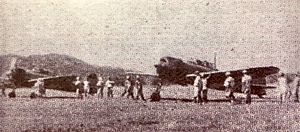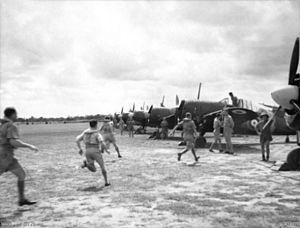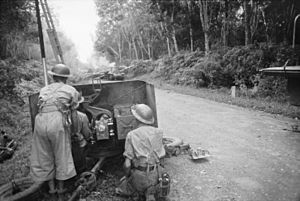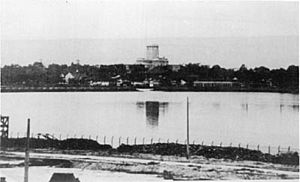Malayan campaign facts for kids
Quick facts for kids Malayan campaign |
|||||||||
|---|---|---|---|---|---|---|---|---|---|
| Part of the Pacific War of World War II | |||||||||
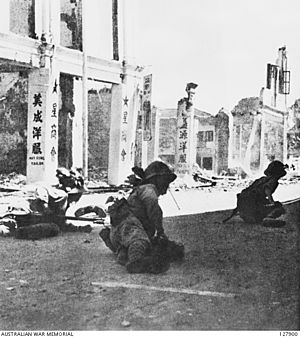 Troops of the Imperial Japanese Army crouch on a street in Johor Bahru in the final stages of the Malayan campaign |
|||||||||
|
|||||||||
| Belligerents | |||||||||
|
|||||||||
| Commanders and leaders | |||||||||
| Units involved | |||||||||
ABDA Command
|
|
||||||||
| Strength | |||||||||
| 130,246 troops 253 aircraft 810 artillery pieces 208+ anti-tank and anti-aircraft guns 54 fortress guns 250+ AFVs 15,400+ motor vehicles |
125,408 troops 799 aircraft 440+ artillery pieces 265 tanks 3,000+ trucks |
||||||||
| Casualties and losses | |||||||||
| 130,246 (Including the casualties of the Battle of Singapore) 7,500–8,000 killed 11,000+ wounded ~120,000+ captured or missing |
9,657 (Including the casualties of the Battle of Singapore) 3,507 killed 6,150 wounded 30+ tanks destroyed 108–331 aircraft damaged or destroyed |
||||||||
The Malayan campaign was a major military event during World War II. It took place in British Malaya (modern-day Malaysia) from December 8, 1941, to February 15, 1942. This campaign involved the Allied forces (like Britain, India, Australia, and Malaya) fighting against the Axis forces, mainly Japan.
The Japanese army quickly defeated the British Commonwealth forces. A key reason for their success was their smart use of bicycle infantry. These soldiers could move quickly through the thick jungle. They also used light tanks, which the Allies did not have. Even though British engineers blew up over a hundred bridges to slow them down, it didn't stop the Japanese for long.
By the end of the campaign, the Japanese had won, capturing Singapore. They suffered about 9,657 casualties (soldiers killed or wounded). The Allied forces, however, had a much higher number of losses, with around 130,246 casualties. This included about 7,500 to 8,000 killed, over 11,000 wounded, and more than 120,000 captured or missing.
Contents
Why the Malayan Campaign Happened
Japan's Reasons for War
By 1941, Japan had been fighting in China for four years. They needed many resources, especially oil, which they bought from the United States. In 1940 and 1941, the United States, Britain, and the Netherlands stopped selling oil and war materials to Japan. This was meant to help China and make Japan stop its military actions there.
Japan saw this as a big problem. Instead of leaving China, they decided to attack American, British, and Dutch territories in Southeast Asia to get the resources they needed. Japan gathered its troops in 1941 on Hainan Island and in French Indochina. The Allies noticed this buildup, but Japan said it was for their operations in China.
When Japan invaded, they had over 200 tanks and nearly 800 aircraft. The Allied troops in Malaya had very few tanks, only 23 old ones, and they were not strong enough for battle. The Allies also had only about 250 combat aircraft. Half of these were lost in the first few days of fighting.
Britain's Defense Plans
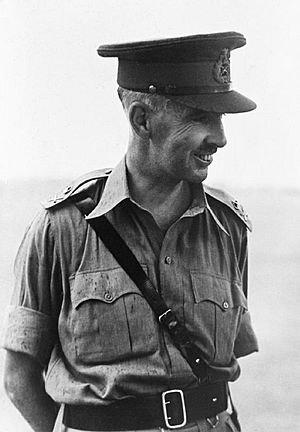
Between World War I and World War II, Britain didn't pay enough attention or money to its military defenses in the Far East. In 1937, Major-General William Dobbie, who was in charge of Malaya's defenses, warned that enemies could land on the east coast during the monsoon season (October to March). He also said they could set up bases in Siam (Thailand).
He predicted that landings could happen at Songkhla and Pattani in Siam, and Kota Bharu in Malaya. He suggested sending many more troops right away, but his advice was not followed. Britain's main plan was to have a strong navy fleet at the Singapore Naval Base to protect its territories and the route to Australia. They hoped this strong navy would scare off any attackers.
By 1940, the army commander in Malaya, Lieutenant-General Lionel Bond, realized that defending Singapore meant defending the whole peninsula. He knew the naval base alone wouldn't be enough to stop a Japanese invasion. Military planners thought they needed 300–500 aircraft for Malaya's air force. However, this goal was never met because Britain needed more resources for the war in Europe and the Middle East.
The defense plan for Malaya had two main ideas: first, that they would get enough warning of an attack to send more British troops; and second, that America would help if an attack happened. By late 1941, when Lieutenant-General Arthur Percival took over, it was clear that neither of these ideas was true. Also, British Prime Minister Churchill and U.S. President Roosevelt agreed that if war started in Southeast Asia, the main focus would be on winning the war in Europe first.
Gathering Information
Japan planned its attack carefully. They gathered information about Malaya using a network of spies. These spies included Japanese embassy staff, unhappy Malayans, and Japanese business people. A British intelligence officer, Captain Patrick Stanley Vaughan Heenan, also helped Japan by providing information.
Before the war, Japanese intelligence officers like Iwaichi Fujiwara set up secret offices. These offices connected with groups in Malaya and India that wanted independence, like Kesatuan Melayu Muda. Japan gave these groups money. In return, the groups gave Japan information about Allied troop movements and strengths before the invasion.
Because of this spy network, Japan knew where the Allied forces were based. They also had good maps of Malaya and local guides to help them.
November 1941 Warnings
In November 1941, Britain learned that Japan was building up a large number of troops in French Indochina. It seemed like Thailand and Malaya were both in danger. British planners thought Japan might use Thailand's Kra isthmus to invade Malaya. To stop this, they made plans for a surprise attack on southern Thailand, called Operation Matador. However, when the invasion became very likely, Britain decided not to use these plans for political reasons.
Japan Invades Malaya
The Malayan campaign began on December 8, 1941. The 25th Army, led by Lieutenant General Tomoyuki Yamashita, landed on the northern coast of Malaya at Kota Bharu. They quickly began moving down the eastern coast. Another Japanese group, the 5th Division, landed in Thailand at Pattani and Songkhla, then moved south into western Malaya.
French Indochina was under French control, but they had to cooperate with Japan. So, the Japanese military used their ports and built air bases there. Japan also forced Thailand to help with the invasion, though Thai troops fought back for eight hours.
At 4:00 AM on December 8, 17 Japanese bombers attacked Singapore. This was the first air raid on the colony. It showed the British that Japanese bombers from Indochina could now reach Singapore.
The Japanese first met resistance from the III Corps of the British Indian Army. The Japanese quickly surrounded and forced the surrender of individual Indian units defending the coast. The Japanese had a small advantage in numbers in northern Malaya. They were much better in air support, tanks, and battle experience from the Second Sino-Japanese War. The Allies had no tanks, which was a big problem for them.
The Japanese also used bicycle infantry and light tanks. This allowed their forces to move very quickly through the thick tropical rainforest and its paths. The Japanese didn't bring bicycles with them. They knew from their spies that there were plenty of suitable bikes in Malaya. They quickly took what they needed from civilians and shops.
A plan called Operation Krohcol was started on December 8 to replace Operation Matador. However, these troops were easily defeated by the Royal Thai Police and the Japanese 5th Division. The British navy's Force Z (including the battleships HMS Prince of Wales and HMS Repulse) arrived just before the fighting began. Japanese aircraft from Indochina sank Prince of Wales and Repulse on December 10. This left the east coast of Malaya unprotected, allowing the Japanese to continue their invasion.
Air Battles
Allied Air Weakness
The Allies had very few modern aircraft in Malaya because it was not a top priority. They also didn't think Japanese aircraft were a big threat. In 1941, the Allies believed Japan only had a few hundred old, poor-quality planes. They also thought Japanese pilots were not very good.
Before the invasion on December 8, the Allies had 75 aircraft in northern Malaya and 83 in Singapore. The only fighter squadron in northern Malaya had just 12 Brewster Buffalos. The Japanese, however, had at least 459 aircraft ready.
Japanese Air Power
The Japanese Navy's 22nd Air Flotilla, with 110 aircraft, took part in the first attacks on Malaya. These planes were based near Saigon. This group included bombers and fighters. The 22nd Air Flotilla was key in sinking the British battleships Prince of Wales and Repulse on December 10, 1941.
The Japanese Army also had many aircraft involved in the campaign. In total, there were 354 Japanese Army aircraft and 110 Japanese Navy aircraft. These included various types of fighters, bombers, and reconnaissance planes. Most Japanese pilots had combat experience from fighting in China and against the Soviets. They were also very well trained.
Allied Aircraft and Pilots
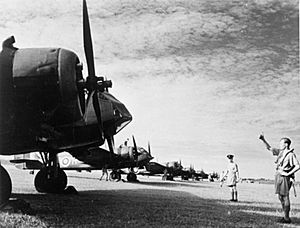
The Allies in Malaya and Singapore had four fighter squadrons. They used the Brewster Buffalo, which many historians say was not a very good plane. It had engine problems, was hard to maneuver, and often overheated. Pilots tried to make it better by removing heavy parts like armor and radios.
The Allies also had squadrons of Bristol Blenheim bombers, Lockheed Hudsons, and old Vickers Vildebeest torpedo bombers. There were also some Catalina flying boats.
The Allied squadrons faced many problems. They lacked spare parts and support staff. Their airfields were hard to defend and had no early warning systems for attacks. There was also a Japanese spy among the Allied air liaison staff. Because of this spy, Japan knew how strong the Allied air force was and where their planes were located before the invasion.
Many Allied pilots lacked proper training. For example, 20 of the 169 Buffalo planes were lost in training accidents in 1941. Two days before the attack on Malaya, Allied planes spotted the Japanese invasion fleet. However, the British commander, Robert Brooke-Popham, did not allow them to bomb the convoy.
Air Campaign Begins
On the first day of the invasion, Japanese air attacks focused on Allied air bases. They bombed airfields at Alor Star, Sungai Petani, and Butterworth. A total of 60 Allied aircraft were destroyed on the first day, mostly on the ground.
Allied planes that did fight performed okay against some Japanese fighters. But more and more Japanese fighters appeared, including better types. These quickly overwhelmed the Allied Buffalo pilots, both in the air and on the ground.
While fighting the Japanese landings, Allied Hudson planes became the first aircraft to attack in the Pacific War. They sank a Japanese transport ship and damaged two others off the coast of Kota Bharu.
By December 9, Japanese fighters were using airfields in Thailand and Kota Bharu. The Allies tried to attack a Japanese airfield, but Japanese planes intercepted them, destroying most of their bombers. Within the first week, Japan had control of the skies. This left Allied ground troops and ships completely open to air attacks.
On December 22, one Allied pilot, Sergeant Malcolm Neville Read, bravely crashed his Buffalo into a Japanese fighter over Kuala Lumpur.
By late December, the Japanese had taken control of the air. This forced Allied fighter squadrons to move to Singapore. Many planes were lost, and some squadrons had to combine. This left the Allied ground troops and shipping very vulnerable to air attacks.
In January 1942, 51 new Hurricane fighter planes arrived in Singapore, along with 24 experienced pilots. These Hurricanes were quickly put together. They were armed with more machine guns, but this made them slower. These new planes helped, but the Japanese still had too many aircraft.
By mid-January, most Allied bombers were moved to Sumatra. On January 26, Allied planes attacked the Japanese invasion fleet at Endau but suffered heavy losses. The remaining planes were moved to Sumatra on January 31.
In the end, over 60 Brewster Buffalo aircraft were shot down in combat. Another 40 were destroyed on the ground, and about 20 more were lost in accidents. Only about 20 Buffalos made it to India or the Dutch East Indies. The last working Buffalo in Singapore flew out on February 10, just five days before the island fell.
Japanese Advance Down Malaya
The Japanese forces quickly defeated Allied troops at the Battle of Jitra on December 11, 1941. They moved south from Thailand, supported by tanks. The Japanese also quickly moved inland from their landing spot at Kota Bharu on the northeast coast. This overwhelmed the northern defenses.
Without a strong navy, Britain could not stop Japanese ships off the coast of Malaya. These ships were very helpful to the invaders. With almost no Allied planes left, the Japanese also controlled the skies. This left Allied ground troops and civilians open to air attacks.
The Malayan island of Penang was bombed daily by the Japanese starting December 8. It was abandoned on December 17. Arms, boats, supplies, and a working radio station were left behind for the Japanese. The quick evacuation of Europeans from Penang, while leaving local people behind, caused much embarrassment for the British. It also made the local population feel angry towards them.
On December 23, Major-General David Murray-Lyon was removed from command of the Indian 11th Infantry Division, but it didn't change much. By the first week of January, Japan had taken control of all of northern Malaya. At the same time, Thailand officially became an ally of Japan. Japan then allowed Thailand to take back control of several areas in northern Malaya.
The Indian 11th Infantry Division managed to slow down the Japanese advance at Kampar for a few days. The Japanese suffered many casualties there because the terrain made it hard for them to use their tanks or air power. However, the 11th Indian Division had to retreat when the Japanese landed troops by sea south of Kampar. The British then pulled back to positions at Slim River.
At the Battle of Slim River, two Indian brigades were almost completely destroyed. The Japanese used surprise and tanks very effectively in a risky night attack. This successful attack forced Percival to replace the 11th Indian Division with the 8th Australian Division. It also cleared the way for the Japanese to reach Kuala Lumpur.
The city of Kuala Lumpur quickly fell. The Japanese entered and took control of the city without a fight on January 11, 1942. Singapore Island was now less than 200 kilometers away for the invading Japanese army.
Defending Johor
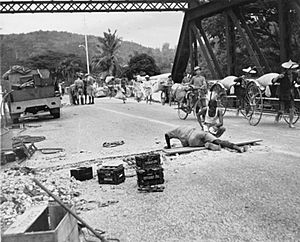
By mid-January, the Japanese reached Johore, the southernmost state in Malaya. On January 14, they met troops from the Australian 8th Division, led by Major-General Gordon Bennett. This was the first time these two forces fought in the campaign.
During battles with the Australians, the Japanese faced their first major setback. This was due to the strong resistance from the Australians at Gemas. The battle, which happened around the Gemencheh Bridge, was costly for the Japanese, who lost up to 600 soldiers. However, the bridge, which had been blown up during the fighting, was repaired by the Japanese within six hours.
As the Japanese tried to go around the Australians to the west of Gemas, one of the bloodiest battles of the campaign began on January 15. This was on the peninsula's west coast near the Muar River. Bennett had assigned the 45th Indian Brigade, a new and not fully trained group, to defend the river's south bank. But Japanese units landed from the sea and went around them. The brigade was almost completely destroyed, and its commander and all three of his battalion commanders were killed.
Two Australian infantry battalions sent to help the 45th Brigade were also surrounded. Their escape route was cut off. One of the Australian battalion commanders was killed in the fighting near the town of Bakri. During the fighting at Bakri, Australian anti-tank gunners destroyed nine Japanese tanks. This slowed the Japanese advance enough for the remaining soldiers from five battalions to try to escape from the Muar area.
Led by Australian Lieutenant-Colonel Charles Anderson, the remaining Indian and Australian troops formed the "Muar Force." They fought a desperate four-day retreat. This allowed other Commonwealth troops retreating from northern Malaya to avoid being cut off and to reach safety. When the Muar Force reached the bridge at Parit Sulong, they found it was strongly held by the enemy. Anderson, with many dead and wounded soldiers, ordered "every man for himself." Those who could, escaped into the jungles, swamps, and rubber plantations to find their division headquarters. The wounded were left behind. Most of them were killed in the Parit Sulong Massacre. Anderson received a Victoria Cross medal for his brave retreat. The Battle of Muar cost the Allies about 3,000 casualties.
On January 20, more Japanese landings happened at Endau, despite an air attack by Allied bombers. The final Allied defense line in Johore was now under attack. On January 27, Percival received permission to order a retreat across the Johore Strait to the island of Singapore.
Retreat to Singapore
On January 31, the last organized Allied forces left Malaya. Allied engineers blew up a 70-foot-wide hole in the causeway that connected Johore and Singapore. A few soldiers still waded across in the next few days. Japanese soldiers and spies, often dressed as Singaporean civilians, soon began crossing the Straits of Johor in inflatable boats.
In less than two months, the Battle for Malaya had ended. It was a complete defeat for the Commonwealth forces. They had to retreat from the Malay Peninsula to the fortress of Singapore. Nearly 50,000 Commonwealth troops were captured or killed during the battle. The Japanese Army invaded Singapore Island on February 7. They finished conquering the island on February 15, capturing 80,000 more prisoners out of 85,000 Allied defenders. The last battle before the surrender was fought by the Royal Malay Regiment at Bukit Candu on February 14.
Key Battles of the Campaign
- Battle of Kota Bharu (December 8, 1941): Japanese troops landed at Kota Bharu. Despite strong defenses, they succeeded in landing most of their forces.
- Bombing of Singapore (December 1941): Japanese bombers attacked Singapore, showing their air power.
- Operation Krohcol (December 8, 1941): A British plan to advance into Thailand failed due to delays and Thai resistance.
- Sinking of Prince of Wales and Repulse (December 10, 1941): Two major British warships were sunk by Japanese aircraft. This was the first time battleships at sea were sunk by planes.
- Battle of Jitra (December 11–13, 1941): Japanese forces quickly defeated Allied troops, helped by their tanks.
- Battle of Kampar (1941): The 11th Indian Division delayed the Japanese for a few days, causing them heavy losses.
- Battle of Slim River (1942): The Japanese used a surprise night attack with tanks, almost destroying two Indian brigades.
- Battle of Gemas (1942): Australian troops put up strong resistance, causing many Japanese casualties.
- Battle of Muar (1942): A very bloody battle where Allied forces suffered heavy losses, but a small group fought a brave retreat.
- Battle off Endau (1942): Japanese landings continued despite Allied air attacks.
- Battle of Singapore (1942): The final battle where the Japanese captured Singapore Island.
See also
- Far East prisoners of war
- Japanese invasion of Thailand
- Japanese occupation of Malaya
- World War II



